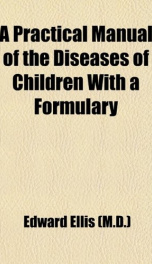a practical manual of the diseases of children with a formulary

Purchase of this book includes free trial access to www.million-books.com where you can read more than a million books for free. This is an OCR edition with typos. Excerpt from book: tions may occur just when convalescence seems about to take place. The most favorable prognostic is a fall in the temperature. The duration of the disease being from twenty-eight to thirty days, some guide to prognosis may be found in the time elapsed; for instance, great exhaustion about the twelfth or thirteenth day would be unfavorable, as there would be yet a long time to run, while a similar amount of exhaustion on the twenty-sixth or twenty- seventh day would not cause so much alarm. Treatment.At the commencement of an attack of typhoid fever it is of great importance to remember that from about twenty-one to twenty-eight days have to be got over, and that no treatment whatever can shorten the duration of the fever. And yet in no disease, perhaps, is the skill of the physician more needed or more shown. Of foremost importance will be to place the child in bed in a large well-ventilated room; the precautions against infection recommended under scarlatina should be practiced; but it is well to bear in mind that typhoid is but slightly infectious as compared with that disease. Then great cleanliness will be necessary, all stools and secretions must be immediately removed, and should be passed into vessels containing Condy's fluid or carbolic acid. The diet will require at first to be plain, simple, un- stimulating, such as beef tea, veal tea, chicken broth; the farinacea must be. charily given lest diarrhoea be provoked. Light puddings (without currants) and milk may be freely allowed. Sir William Jeiner has pointed out that the too indiscriminate employment of milk in fevers is not unattended with bad consequences. He says "curds form in the stomachthe digestive powers are weakened by feversthe curds remain unchanged, and produce considerable disturbance of the system...
Info about the book
Author:
Series:
Unknown
ISBN:
0979294525
Rating:
3/5 (5)Your rating:
0/5
Languge:
English
Users who have this book
Users who want this book
What readers are saying
What do you think? Write your own comment on this book!
write a commentGenre
if you like a practical manual of the diseases of children with a formulary try:
Do you want to exchange books? It’s EASY!
Get registered and find other users who want to give their favourite books to good hands!


